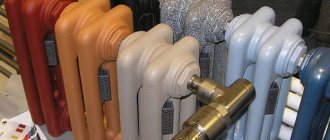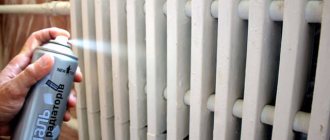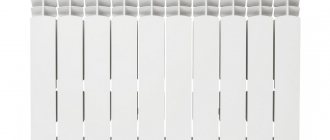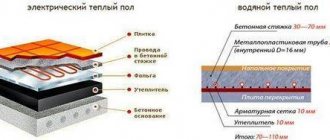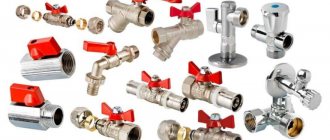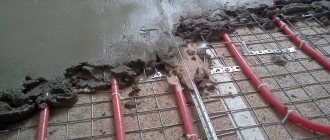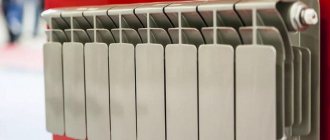Long gone are the days when a person needed to build a fire to heat his home, maintain it by being on duty around the clock and throwing wood on the fire. The civilized world has already emerged from the caves of the primitive communal system; people live in comfortable apartments and private houses with a central or individual heating system.
Over the past half century, heating equipment has changed a lot not only in appearance, but also in functional purpose. Modern models of radiators (batteries) have an aesthetic appearance and are made of various materials: cast iron, bimetal, aluminum.
The need to replace old cast iron batteries may arise due to major repairs, remodeling, or replacement of failed radiators.
Calculation of the number of radiators
Usually, there are no problems with the number of heating devices: they are installed in place of the old ones, most often under the windows, to prevent the appearance of condensation. However, if the room is large enough or non-standard, then the number of radiators is better calculated using the simplified formula: N=S*100 W/∆T, in which:
- N - number of radiators;
- S is the total area of the room;
- ∆T is the heat transfer value of one heating battery (this parameter can be found in the technical data sheet of the product).
This formula is valid when the ceiling height does not exceed 3 m. In other cases, it is necessary to replace 100 W with 40*h (the last symbol means the ceiling height in meters). If the region is constantly below 30 degrees below zero in winter, then the number of radiators needs to be increased by 15-20%.
How to paint
If it is not possible to replace old cast iron batteries with more modern heating devices, many people repaint the radiators in the desired color. The entire painting process can be divided into several stages:
- Selection of paint;
- Surface cleaning;
- Paint application;
- Drying the product.
To treat such surfaces, it is recommended to use alkyd dyes, heat-resistant varnish with the addition of bronze or aluminum powder. In addition, for such work you can use water-based paint, to which you can add various pigments to obtain the desired color.
At the initial stage of work, working tools are prepared and the surface of heating devices is cleaned. This can be done using a wire brush, coarse sandpaper or an angle grinder equipped with a special attachment. To facilitate the work, special solutions are used that help destroy the old coating.
Note! When using solvents, be sure to ventilate the room and use a respirator to protect your respiratory system.
The washing liquid is applied to the surface using a brush. After leaving for a certain time indicated on the solvent packaging, the old layer of paint will begin to wrinkle and peel off. The coating can be removed with a small metal spatula. The final cleaning of the battery is carried out using a metal brush.
At the next stage of work, the radiator is thoroughly cleaned with sandpaper and primed, which will help the paint adhere better. The best type of primer is considered to be the GF021 brand; it is suitable for any type of dye.
Next, a layer of paint is applied using a paint brush. The composition is applied carefully from top to bottom. For better coloring, the dye is applied in several layers. In this case, you need to take a break between the stages of applying the coloring composition.
Option 2 if you plan to replace the battery at will
If, according to plumbers, there is no urgent need to replace the battery, but you still want to replace the radiator, there are two options.
Method 1 – classic (turn off the heating)
To carry out repair work, you need to contact the organization that is responsible for the heat supply to the house and obtain permission to turn off the heating. As a rule, such permission can be obtained if the outside temperature is not lower than minus 10 - minus 15 degrees. If it is colder outside, turning off the heating may be refused. Also, permission to replace the battery will be difficult to obtain if you need to replace radiators in the entire apartment. The service for turning off heating risers is usually paid.
The shutdown time must be agreed upon with the technician who will carry out the work. It is necessary to notify all neighbors that the heating will be turned off in the house.
It is very important to choose a professional team of craftsmen so that the work is completed in the minimum time. If the work drags on, residents and their neighbors will have to stay in cold apartments
Method 2 – modern (freezing heating pipes)
Technologies do not stand still, and apartment owners are provided with new convenient opportunities. Special equipment has appeared for freezing heating pipes. The equipment creates an ice plug in the pipes, and the batteries can be changed without turning off the heating. The work is carried out much faster; you do not need to obtain permission to turn off the heating. There is a condition - freezing will work when circulation in the system completely stops. Let's take a closer look at how this works.
To replace the battery, it is necessary to “stop” the water in the pipes. To do this, in the classic version, which we discussed above, water is drained from the riser, and after the work is completed, the system is filled again. When using a pipe freezer, these two steps are not required. Certain sections of pipes freeze, temporarily stopping the water. An ice plug prevents water from moving through pipes and lines.
There are several types of devices for freezing pipes. Most of them run on liquid carbon dioxide. Such devices have certain features:
- The need to have spare cylinders, which will be needed to maintain the formed ice plug during work.
- Constant monitoring of the presence of gas in cylinders is mandatory.
- High-quality ventilation is required during work due to the risk of carbon dioxide accumulation.
There are also other types of devices for which you do not need to buy refrigerant and bring cylinders. These include, for example, Rothenberger ROFROST TURBO 62206. Such devices provide fast and reliable freezing without the need to transport gas cylinders. The freezing performance of the devices is high - the apartment will not have time to “freeze out”.
Devices for freezing pipes have a wide range of applications, but it is better to clarify the technical feasibility of their use specifically at your facility with specialists. Whatever battery replacement method you choose, now you know that replacing the battery in winter is quite possible.
Those who have encountered replacing batteries in an apartment know that summer is the most suitable period for this. Despite the fact that water is in the pipes in the summer (to avoid rusting the inner surface of the pipes), this procedure is much more difficult to carry out in winter. This is due to the fact that in summer people do not physically feel that the water has left the risers, and in winter the water is drained is fraught with a sharp drop in temperature in apartments, and this can cause great inconvenience to you and your neighbors.
However, many people are forced to resort to replacing batteries in winter. ZhEK and DEP very willingly agree to replacement during this period. Some even believe that carrying out work during this period gives more advantages than disadvantages, because to check the quality you do not need to wait several months before the start of the heating season. You can check the quality of installation and welding work on the same day after resuming the water supply to the risers. In addition, in winter, due to low popularity, battery replacement services are somewhat lower.
One of the disadvantages is that the replacement procedure during the heating season should be carried out in the shortest period of time so that heat losses in your and neighboring apartments are minimal.
As we can see, replacing batteries during the heating season is quite possible and even has some advantages compared to the summer period.
Laying heating pipes
Once the old heating system is removed, it's time to think about a new one. One of the questions in the instructions on how to change the battery in an apartment is the method of laying new pipes. First of all, one of two options is selected:
From an aesthetic point of view, hidden gasket is much better. Communications will be hidden from human eyes. However, this method has a number of disadvantages:
- Further maintenance of the system is difficult
- The cost of the work being carried out increases, and additional costs for building materials will appear in the estimate.
- A certain percentage of the heat will go to heating the decorative structure
The advantages of open heating systems, due to which they are preferred, are obvious to everyone:
- Lower cost of installation work, since materials are consumed in minimal quantities
- The pipes are in direct contact with the environment, thereby eliminating heat loss
- Simple further maintenance of communications
- Small time costs for laying pipes
Hidden pipe laying
As noted, hidden pipe laying is labor-intensive and time-consuming work. First, prepare:
- For natural circulation of the coolant, the pipe is placed directly into the suspended ceiling, and the outlet risers are run along a protective decorative box
- For forced circulation, a good solution would be to lay pipes in the walls or floor
- Markings are applied to the working surfaces and grooves are made with a hammer drill or grinder
The pipe is secured directly in the grooves with clips. In this case, near future radiators, the line should end with removable threaded adapters.
It is necessary to start decorating surfaces only after all the batteries are in place and crimping has been carried out.
Open pipe laying
Laying pipes using the open method is more popular. At the first stage, you need to install radiators, an expansion tank, a boiler and other heating equipment.
In order for the pipes to look aesthetically pleasing, their exact location should be calculated. Diagrams sketched on paper taking into account the location of the furniture will not be superfluous.
Open laying can be organized in one of the following ways:
- The upper discharge pipe of large internal cross-section is laid between the radiator plugs under the window sill, while the pipe running along the bottom is led along the floor
- Both pipes are routed along the floor, but this method is only suitable for forced circulation
- For natural coolant circulation, the lower pipe is placed directly near the floor, and the upper pipe is placed as high as possible
Having decided on the method of laying the pipe line, you need to mark the walls and install retaining clips. The frequency of their location is 1-2 m. It is necessary to take into account that it is recommended to make the areas between the radiators solid. In non-standard areas, two clips are placed at the junction points - on one side and on the other.
Particular attention is paid to branches and turns. Before trimming, you will have to take careful measurements, have a design and engineering vision
We also advise you to find out more about individual heating in the apartment
Installation of new batteries
Before installing heating radiators in the apartment, you need to calculate everything again and accurately measure their location. In this case, you should not violate the rules prescribed in specialized documents (SNiP):
- Approximate distance between the floor and the bottom edge is 15 cm
- The approximate distance between the window sill and the top edge is 15 cm
- The gap between the radiator and the wall is at least 2 cm
First you need to secure the brackets on which the new radiators will be hung. Then nuts are put on them. All connections must be well sealed to prevent water leakage. It is also recommended to apply tow. There will be taps at each entrance.
The final working stage will be to check the entire heating system for operability. To do this, one end should be plugged, and on the other side, create a pressure with a pump or compressor that exceeds the working one by 1-2 atmospheres. If after some time the readings of the measuring pressure gauge do not change, you can screw in all connections and connect to the central system.
There is definitely something difficult and impossible to do in how to change the battery in an apartment. However, you can’t count on easy work either. After completing the work, it is recommended to call a technician and let him verify that the system is assembled correctly.
Dismantling the old system
To remove old pipes and radiators, you should agree with the neighbors above and below to replace them. If this was not possible, then the question of how to change a heating radiator in an apartment becomes exclusively personal.
How to replace a heating radiator in an apartment? Dismantling the old system begins with draining it. Housing office workers must do this, since a pump will be required to completely pump out the coolant, after which they shut off the water at the level of the radiators that need to be replaced.
How to change heating batteries in an apartment? It will be necessary to cut off the old pipes at the floor and ceiling level and weld new ones, it is better if they are aluminum-propylene.
If you are replacing heating radiators (batteries) in an apartment with your own hands, then you will need to prepare in advance additional elements that are not included with them:
- blind and 2 pass-through plugs;
- gaskets for plugs;
- reinforced pipes;
- a tap that will be used to shut down and carry out further preventative work on the system;
- PPR pipe (20 mm) for connection to the neighbors’ system (if there is permission from them).
The tools you need to have are:
- grinder;
- drill;
- adjustable wrench;
- level;
- gas soldering iron.
After that. Once the level marks the place where the old batteries are cut, you can begin to dismantle them, leaving at least 1 cm of thread for connecting the new system.
Only after identifying the places (taking into account all the parameters) where the new radiators will be located can you begin to install them.
Some requirements during the work
The fact that the heating system is in working order during the winter period will allow you to immediately evaluate the quality and efficiency of the work performed. should be carried out one by one, when not all radiators in the apartment are turned off, but only one of them. After it has been put into operation, it is the turn of the next one. The installation of one battery can be completed within one hour, but for this (preliminary) measurements must be taken and all tools and components must be prepared.
In addition, we must remember that the radiator is mounted horizontally, and it must be parallel to the wall. It is installed on three brackets, one of which is located at the bottom and two at the top; the main load will fall on them. In the case of a large number of battery sections (more than 12), another bracket is (additionally) fixed in the upper part of the wall. It is necessary to maintain a distance between the top of the radiator and the bottom of the window sill, it must be at least 10 cm, otherwise the thermal curtain in front of the window will be weak.
The representative of the service organization (after completion of all work) is obliged to turn on the risers of the heating system. You must check the tightness of the joints so that there are no leaks at the joints of pipelines, shut-off and control valves.
Batteries are replaced in winter in emergency cases when they do not warm the room. This issue is agreed upon with the organization servicing the house. The work is carried out by a specialized organization. The reasons why you need to replace your batteries in winter can vary. It is possible that an accident occurs and the replacement date cannot be postponed until the end of the heating season, then this work must be done immediately. Replacing a heating device, installing a screen or other dismantling and installation work can be carried out without hindrance in these cases. For example, heating devices that have operated for more than twenty years cannot fully perform their functions of heating rooms, and therefore must be replaced.
Some requirements during the work
The fact that the heating system is in working order during the winter period will allow you to immediately evaluate the quality and efficiency of the work performed. Replacement must be carried out one by one, when not all radiators in the apartment are turned off, but only one of them. After it has been put into operation, it is the turn of the next one. The installation of one battery can be completed within one hour, but for this (preliminary) measurements must be taken and all tools and components must be prepared.
In order to avoid loss of heat and your own health, and not to pay extra money for heating your home, the batteries must be installed correctly. In addition, you must remember that the radiator is mounted in a horizontal manner, and it must be parallel to the wall. It is installed on three brackets, one of which is located at the bottom and two at the top; the main load will fall on them. In the case of a large number of battery sections (more than 12), another bracket is (additionally) fixed in the upper part of the wall. It is necessary to maintain a distance between the top of the radiator and the bottom of the window sill, it must be at least 10 cm, otherwise the thermal curtain in front of the window will be weak.
The representative of the service organization (after completion of all work) is obliged to turn on the risers of the heating system. You must check the tightness of the joints so that there are no leaks at the joints of pipelines, shut-off and control valves.
www.kakprosto.ru
Activities of the housing office when changing radiators
When residents decide that their heating system is outdated, they ask a fair question: who should change the heating radiators in the apartment.
In this matter, you need to rely on the following facts:
- The change was caused by a failure (depressurization or other reason) of the system, which means that all work must be carried out by utility workers
. - Old radiators heat, albeit poorly, but if there is a desire to decorate the apartment with more modern analogues, then this “whim” will fall on the shoulders of the user himself.
In any case, the heating batteries in the apartment are replaced through the housing office, even if all expenses are borne by the residents. Without permits, any work is considered illegal. Sometimes consumers ignore such a requirement, wanting to draw up documentation after the fact of the work performed. This can only happen if the housing office workers consider the new heating system safe for the entire structure.
If residents have a question about whether it is worth changing the heating batteries in the apartment, then the answer is a definite “yes” if they have become unusable or are simply old. The replacement procedure is not that complicated, even taking into account the paperwork. Choosing a team suitable for this work will also not be difficult, but knowing that for the next 25-30 years the apartment will be heated by beautiful and modern radiators is worth it.
Batteries are replaced in winter in emergency cases when they do not warm the room. This issue is agreed upon with the organization servicing the house. The work is carried out by a specialized organization. The reasons why you need to replace your batteries in winter can vary. It is possible that an accident occurs and the replacement date cannot be postponed until the end of the heating season, then this work must be done immediately. Replacing a heating device, installing a screen or other dismantling and installation work can be carried out without hindrance in these cases. For example, heating devices that have operated for more than twenty years cannot fully perform their functions of heating rooms, and therefore must be replaced.
Some requirements during the work
The fact that the heating system is in working order during the winter period will allow you to immediately evaluate the quality and efficiency of the work performed. Replacement must be carried out one by one, when not all radiators in the apartment are turned off, but only one of them. After it has been put into operation, it is the turn of the next one. The installation of one battery can be completed within one hour, but for this (preliminary) measurements must be taken and all tools and components must be prepared.
In order to avoid loss of heat and your own health, and not to pay extra money for heating your home, the batteries must be installed correctly. In addition, you must remember that the radiator is mounted in a horizontal manner, and it must be parallel to the wall. It is installed on three brackets, one of which is located at the bottom and two at the top; the main load will fall on them. In the case of a large number of battery sections (more than 12), another bracket is (additionally) fixed in the upper part of the wall. It is necessary to maintain a distance between the top of the radiator and the bottom of the window sill, it must be at least 10 cm, otherwise the thermal curtain in front of the window will be weak.
The representative of the service organization (after completion of all work) is obliged to turn on the risers of the heating system. You must check the tightness of the joints so that there are no leaks at the joints of pipelines, shut-off and control valves.
www.kakprosto.ru
FAQ
Whatever the reason, any action can be taken only after answers to the questions have been received:
- How much does it cost to replace heating batteries in an apartment?
- What permits are needed for this?
- Who has the right to carry out such work?
- What should I replace old cast iron batteries with?
- Is it possible to replace the heating battery in an apartment for free?
- When is it better to change heating batteries in an apartment?
- How to change the heating battery in an apartment yourself and is it possible?
The heating system of a multi-storey building is a rather complex structure in which many elements must be taken into account. If during the repair or replacement of radiators in one apartment malfunctions occur, the entire riser may suffer.
Is it possible to change batteries during the heating season?
The fact is that I want to replace the heating radiators with new ones (the old ones are still in good condition). I have already agreed with the housing cooperative about a replacement, but as it turned out later, they do not install polypropylene pipes. She returned the money back for a service not provided, and at the same time had an argument with the head of the department. I found a company that installs such pipes. I came to the housing cooperative to pay a receipt for draining the riser and I was refused, citing the fact that they do not do this during the heating season. As far as I know, this is not mentioned anywhere.
Am I wrong? And what should I do in this situation? (I’m not going to bow to the boss). Yes, and also, I don’t understand, I’m going to replace 2 radiators in one room, but they say that it’s not 2 risers that need to be drained, but 4, supposedly these risers also communicate with the neighbors’ ones. :009:
In general, it’s not clear with their prices either. At first they told me the amount of 800 for draining 2 risers, then it turned out that supposedly the risers were paired with someone else there, i.e. I need to disconnect not 2, but 4 risers and the amount they told me was 1200 rubles. So I don’t understand 400 rubles for a riser, multiply by 4, well, it doesn’t work out to 1200. And when I asked to see their prices, at first they didn’t want to show them to me, and then they calculated as much as 1900 rubles (this is draining and filling 4 risers + 2 rubles multiplied by the volume of water drained from subsequent floors and from each riser). In general, they confused it as best they could. How to get the truth about the cost of this event? In general, they greyhound as best they can.
The fact is that I want to replace the heating radiators with new ones (the old ones are still in good condition). I have already agreed with the housing cooperative about a replacement, but as it turned out later, they do not install polyurethane pipes. She returned the money back for a service not provided, and at the same time had an argument with the head of the department. I found a company that installs such pipes. I came to the housing cooperative to pay a receipt for draining the riser and I was refused, citing the fact that they do not do this during the heating season. As far as I know, this is not mentioned anywhere.
Am I wrong? And what should I do in this situation? (I’m not going to bow to the boss). Yes, and also, I don’t understand, I’m going to replace 2 radiators in one room, but they say that it’s not 2 risers that need to be drained, but 4, supposedly these risers also communicate with the neighbors’ ones. :009: Who is going to install the “polyurethane” pipes for you? That’s why they refused you, if they were “POLYPROPYLENE” they probably did it themselves.:010:
Who is going to install “polyurethane” pipes for you? That’s why they refused you, if they were “POLYPROPYLENE” they probably did it themselves.:010:
Oh! Thank you for noticing.:flower: Of course, I meant polypropylene pipes. Already fixed it. Our housing cooperative supplies only metal-plastic pipes.
Connection options for heating radiators
Heating battery installation diagram.
When you have to change radiators, the question inevitably arises about how to connect them. There are 2 options for installing heating batteries: series or parallel. The choice depends on the type of radiator. The best heat transfer for aluminum and bimetallic devices is achieved with a parallel connection. The sequential option is better suited for cast iron and steel radiators. However, if you live in an apartment building where, for example, there is a serial system, then you can connect radiators in parallel in your apartment only after approval and consultation with representatives of the housing office. A private house is a different matter. Here you can connect radiators in any way:
Diagram of a horizontal sequential heating system.
- serial connection. This method involves the direct inclusion of heating devices into the overall system. After installation is completed, the coolant is driven under pressure. Serial connection, incl. and repairs are carried out only in the summer, because... it is necessary to turn off the heating on the riser to which the batteries will be connected;
- parallel connection. The point is to connect to the general heating system through a separate embedded heat pipe. This option allows you to repair your heating system without shutting down the overall system. It is enough to install ball valves at the inlet and outlet. The downside is poor heating of the radiators due to insufficient pressure in the line. This is due to the fact that the coolant will flow where there is less resistance, i.e. along the main pipeline, and not along a separate branch.
Not only time is important, but also material
Second, and perhaps most important, is to choose the radiator you will use. Of course, you will choose the most beautiful of all, but you need to choose a battery specifically for your home. If, for example, you live in a multi-storey building, then ordinary aluminum radiators are not suitable for you, then you need to take bimetallic ones (they can withstand higher pressure). Aluminum batteries are more suitable for country houses or cottages.
Another important feature is thermal conductivity. For example, cast iron has worse thermal conductivity than aluminum, and radiators made from it are heavier. Probably the best option is bimetal. As mentioned above, radiators made from it can withstand high pressure. Bimetallic radiators are made of two metals: steel and aluminum. The first provides strength and durability, the second - high heat transfer.
Most often, people replace cast-iron batteries with the same ones only newer or choose bimetallic radiators; they are more wear-resistant than cast-iron ones.
It is also equally important to choose the right pipes. Either steel pipes, copper pipes, or polypropylene pipes should be used. In addition, you need to know the diameter of the pipe and the required length.
Replacing heating batteries in an apartment through the management housing office
At the time of an accident (for example, a radiator has leaked), replacing the heating battery lies entirely within the responsibility of the organization, to whose account residents transfer money for maintaining common property and carrying out major repairs. It cannot be said that such a replacement occurs free of charge. Cases of coercion to purchase new devices are not uncommon. It happens that receipts are issued for the cost of work performed.
The most unpleasant thing is if the battery replacement process is needed in emergency mode during the heating season. And representatives of the management company will begin to evade their obligations, citing the fact that they have neither time, nor workers, or even the radiators themselves. They will remove the old one, install plugs and politely ask you to wait.
It turns out that residents cannot change the batteries in their apartments if they wish, because...
For example, when the replacement has already been made and you plan to legalize it, you should contact an expert commission, which, in turn, if there are no violations of the design parameters, can confirm the legality of the installation of radiators.
An examination of the compliance of heating units with the primary design and the admissibility of their installation in an apartment without damage to the overall system of the entire house is paid for by the owner of the apartment in which he wants to replace the batteries, because
For example, if the batteries purchased by the owner do not correspond to common house heating devices, then the HOA may prohibit their installation. The apartment resident must carry out such work through the housing office and coordinate with his service organization the replacement of batteries.
https://www.youtube.com/watch{q}v=fPWupSzksOw
If it establishes similar ones to those that were provided for during the design and construction of the house, it is enough just to notify the management company without waiting for a special permit. Coordination of work with the HOA When replacing radiators with heating devices of a different type (different from those envisaged by the architects), increasing its area or choosing a new installation location, an experienced specialist is required who will help calculate the possibility of installing heating devices, since the load on all thermal home network.
